
Greetings, Travelers! Do any of you who are stuck at home due to COVID-19 miss the distant scenery outside?
We received a great deal of feedback following the release of our first Developer Insight essay, with many Travelers hoping that we could release some content that introduces the beautiful scenery of Liyue.
In response to these calls, we have been able to invite a member of our art department to explain the thought process behind Liyue's design in detail, using Dihua Marsh as the main reference.
——————Warning: Juicy Details and Heavy Spoilers Ahead——————
Hello, everyone. I'm Ziyuan from miHoYo's art department. At the request of my colleagues from the marketing department, I've come to explain some of our design principles for the Liyue Region of Teyvat.
Two things lie at the heart of our department's thought process: how to fashion a style during the design process, and how to communicate that aesthetic effectively. Since we are designing Teyvat from the ground up as if it were a living, breathing world, each of the seven nations should have its own style. We want to convey the landscapes and customs of each region. Much like regions and cities in our own world, each of these must be unique yet interlinked, enriched by people living there, and connected by those who come to and fro.
Liyue is precisely such a city, brimming with life and culture. Here, the colors and customs of the East build upon one another to paint an exquisite tapestry, and what we want to do here is to display the finer details of this tapestry to everyone.
Design from Difference
Liyue lies to the south of Mondstadt. Departing from the main gate of Mondstadt, we scale the Windwail Highland, trek through Springvale, pass the Dawn Winery by, and come upon some fascinating terrain. Twin peaks intersect in mid-air, forming what almost appears to be an archway. In-game, those who pass through this area call it the Stone Gate.
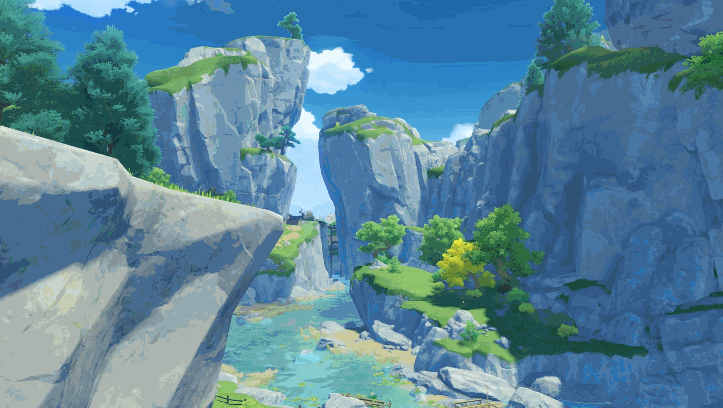
Entrance to the Stone Gate (In-game)
When players set off for Liyue from Mondstadt along the mercantile land route, they essentially must all pass through the Stone Gate. It can be seen as a landmark, and it also marks the boundary between the two regions. Thus, the experience of the Stone Gate directly influences the first impression that players will have of Liyue as a region.
Before designing this locale, we first set a direction for that design. We hoped that the Stone Gate could impart upon players the feeling expressed in Tao Yuanming's poem, Peach Blossom Spring: "After a great many steps, a breathtaking scene appears before one's very eyes." Starting from the Stone Gate, the terrain starts to shift, and the architecture along the path gradually becomes more like that of Liyue. As players pass through the Stone Gate, the scenery opens up, and countless beautiful scenes from right out of a Chinese landscape painting — wholly different from those seen in Mondstadt — begin to reveal themselves.
Several of my colleagues and I hail from Southwest China, and not a few times were we reminded of our hometown as we designed the Stone Gate. The world-famous mountains and rivers of our home proved to be the ideal reference material, and after much discussion, it was agreed that the Karst Landforms emblematic of the southwestern regions would be the basis for Liyue's theme.
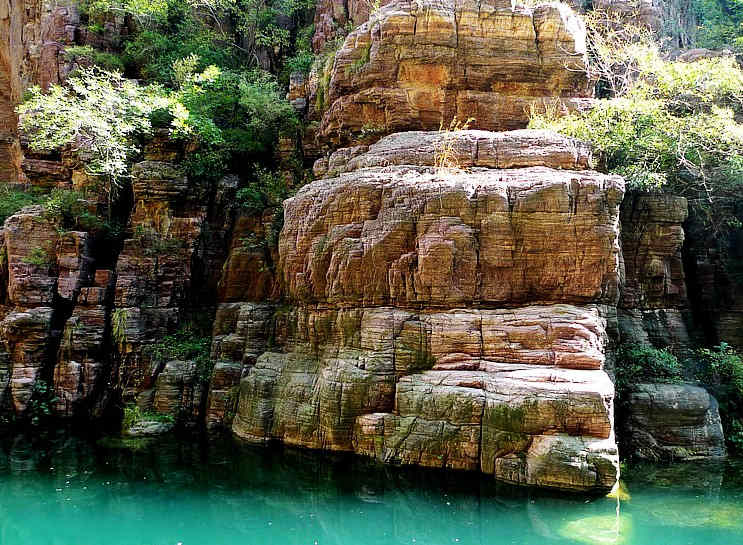
Karst Landform
We brought this style into the game, and began the process of intricately designing mountains and peaks, taking care to remove any trace of human artifice by making each monolith look as natural as possible. This way, we would be able to create the effect of nature set apart, and enhance the naturalness and openness of the gaming experience.
In the initial stages of design, we did consider a canyon-like entrance inspired by the Yixiantian Gap Road (a hiking trail in Southwest China). However, such a narrow strip of road would cause the game experience in this area to be linear and monotonous, so after referencing all sorts of ancient cliff-hewn roads, we finally decided on this design.
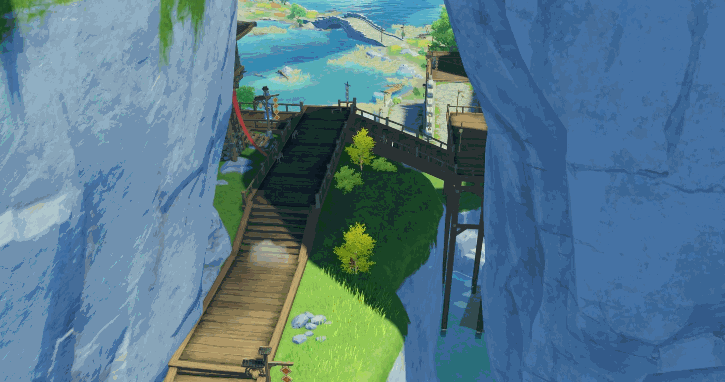
Finalized Stone Gate (In-game)
Design from Life Experience
The first stop after passing through Liyue's Stone Gate is Dihua Marsh.
The task of designing Dihua Marsh was treated almost as solemnly as the Stone Gate. We imagined the player following a winding path beneath the great monoliths at nighttime, gazing up at the sea of stars shining down. This creates quite a magical mood for their journey, which culminates in their arrival at Dihua Marsh just as dawn is breaking. So Dihua Marsh had to be this first stunning sight that the player sees in the light of day.
This train of thought led us to feel that Dihua must be like the beautiful face that emerges when the veil falls away, capturing the aesthetic of Liyue in its full glory. Thus, the design of this locale became the focus of our research.
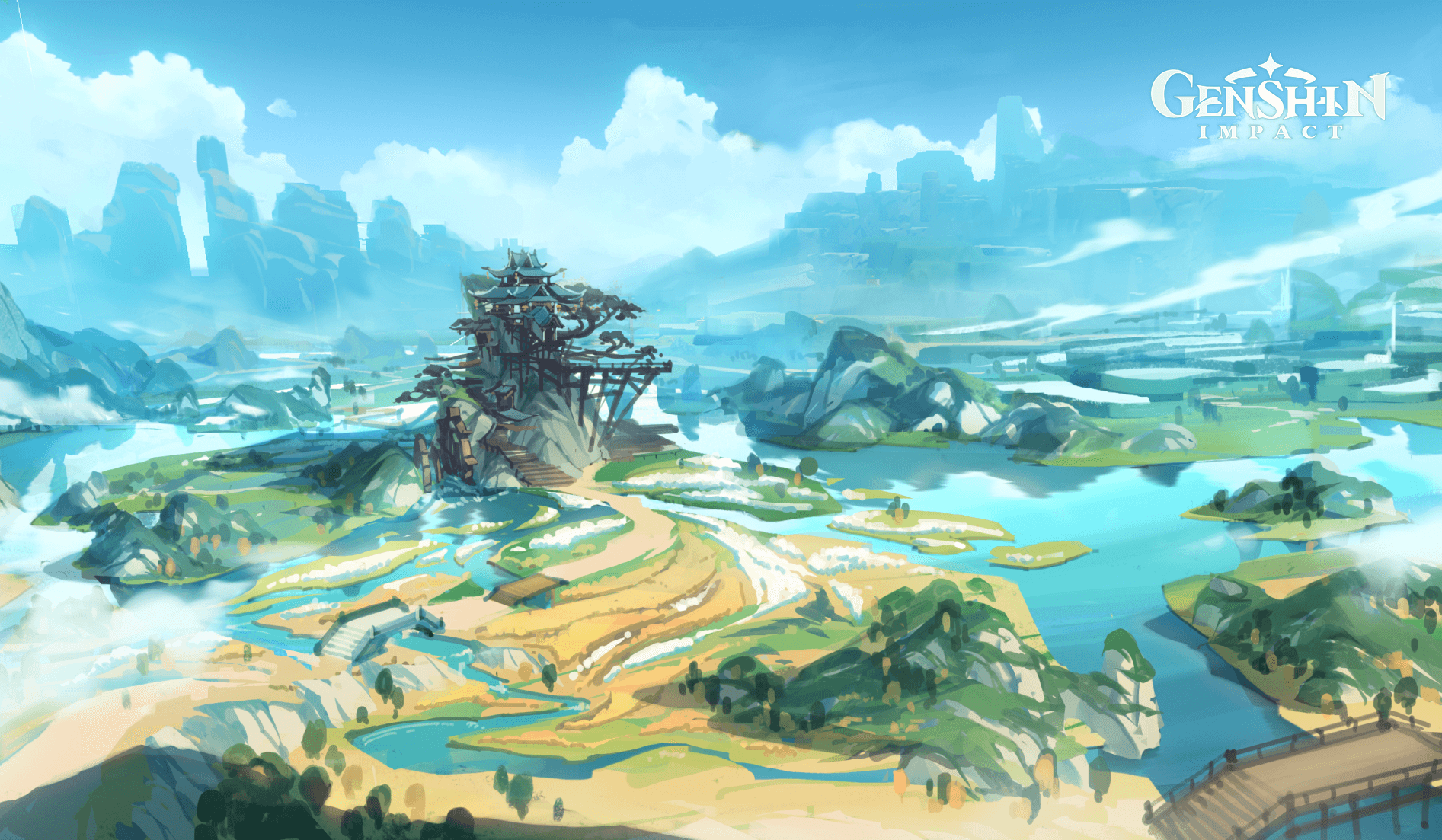
Dihua Marsh Concept Art - III
The most difficult part of this process was unifying an entire art style. How does one do that? Each person has disparate experiences, interpretations and artistic inclinations, and in working together as a team, a great number of disparate creative directions were also born. One person suggested that we could add in the pines and bamboos of Suzhou, and another felt that a Huizhou-style canal town would be best. Someone else proposed the otherworldly natural beauty of Huanglong in Sichuan, and still another spoke of an unforgettable trip they had once taken, suggesting that the area be lined with roaring rivers and misty lakes... It would be accurate to say that this area became the medium for each person's ideals of "Chinese-style beauty," "the beauty of one's hometown," and "the beauty of the land."
Coming from every corner of the world, having led disparate lives and possessing equally different souls, each of us therefore also had our very own imagined "Dihua Marsh," unlike any other. So even though it eventually took on the form you see today, in our hearts, it has a hundred forms and a thousand faces. It is holy ground, from which infinite imagination springs forth in abundance.
After many stylistic clashes, we finally set on a theme: a fantasy that leans close to real scenery. What the art department wanted to do was to keep the style of Dihua Marsh within the realms of Eastern fantasy art.
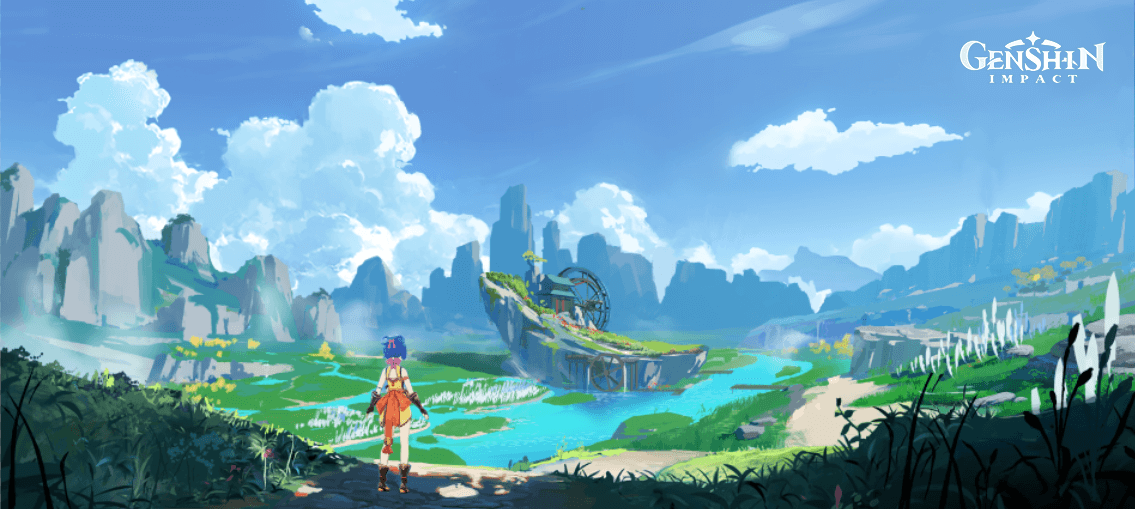
Dihua Marsh Concept Art - V
After deciding on this general theme, we began to discuss such things as "What sort of beauty is unique to Eastern fantasy?" and "What elements of art can only be found in the East?" We hoped that this land would really make an impression on people. It had to not only be pretty, but also unique, capturing both the artistry and dramatic flair of the East.
After going through huge amounts of relevant material, one piece of imagery jumped out at us: reeds. They often feature in period films, and are usually associated with scenes of austerity and bleakness.
But, could they be something else, we asked? What were reeds to us? What were they to me?
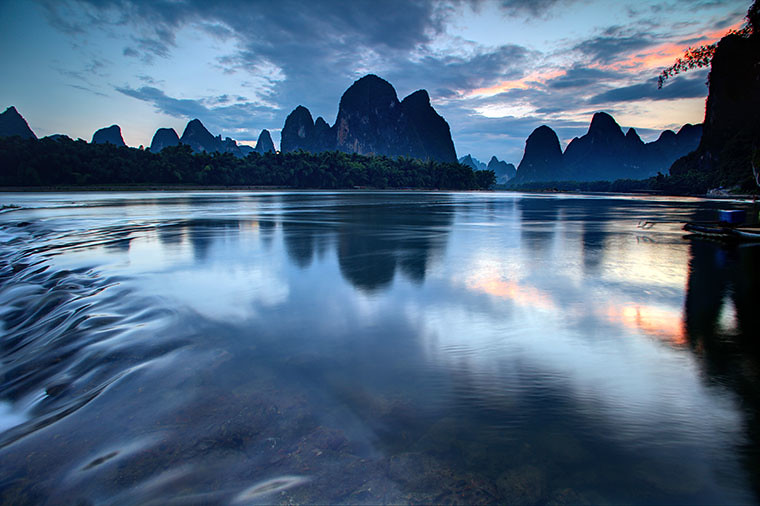
Yangshuo Scenery (for demonstration only)
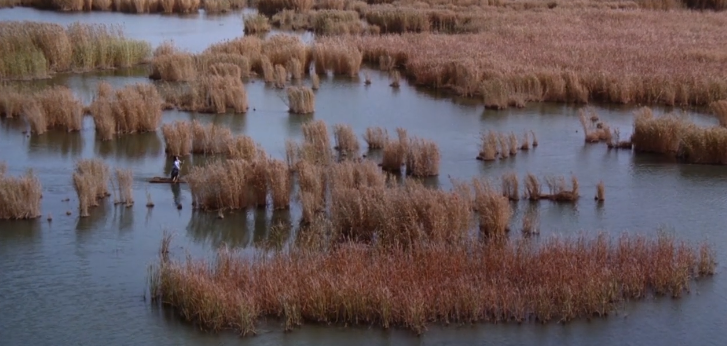
Image taken from the film "A Chinese Odyssey"
As a person born and bred in Guangxi, my schooldays were spent in Guilin City, and my school itself was but a stone's throw away from Yangshuo County. I would go there to hang out when I was free. Yangshuo is situated to the south of the Guilin city area, and between its rolling hills and towering cliffs, it became a wondrous tourism hotspot. I was at home in Yangshuo, delighting in its peaks and stone forests. Against the backdrop of the Karst landforms, these sights were transformed by water bodies, vegetation, and the interplay of light and shadow in such a way that one almost felt the land itself was a living thing, expressing its emotions through these changes in some inscrutable way.
Juxtaposed against this stone scenery were the reeds that lined the banks of the Nanxu River. At sunset, the warm light would waft across from the far bank, turning the entire world into something right out of a painting. It was a beauty that had to be seen to be believed.
Bai Juyi once wrote in The Song of the Pipa Player: "Bidding goodnight to guests at Xunyang River's edge, while the autumn maple and amur shimmer in the wind." (Though reeds and amur silvergrass are not the same thing, the spaces they occupy in artistic expression are connected.)
For me, that which in isolation creates a sense of austere solitude, yet has elegant magnificence at scale, and encompasses both dramatic and natural beauty — that is the beating heart of Eastern fantasy.
According to this visualization, this area should have an ocean of flowers that springs to life beside water. I was also able to move the wonderful memories of my schooldays onto the terrain simulations we did. Thus were laid the foundations of Dihua Marsh, the core area of northern Liyue.
Eastern beauty is about striking a delicate balance — neither overdoing it, nor underdoing it. Aiming to achieve the same balance of content and empty space characteristic of Chinese landscape paintings, we constructed an array of peaks and stone forests in the distance behind that floral sea. The essence of Dihua Marsh we define as follows: vivid, expressive, and free.
Constantly Iterating on Landmarks
After reaching Dihua Marsh, one of the first things players exploring the area will find is the central structure in this area: Wangshu Inn. Sitting atop a towering pillar of rock, it is Liyue's first landmark piece of architecture.
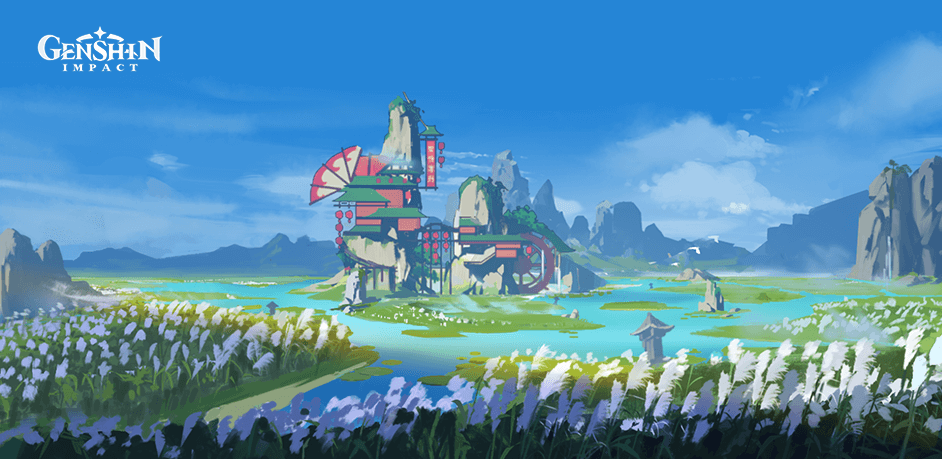
Wangshu Inn Concept Art - VII
From early on in the very first IP Design Document, the name "Wangshu Inn" was already a foregone conclusion. The head of the development team hoped that this inn would "soothe those who gaze out at the scenery," which is basically the literal meaning of 'wangshu' in Chinese. Incidentally, Wangshu is also one of the aliases of the moon in traditional Chinese — specifically it alludes to the beauty of the moon goddess. In that sense, the view from Wangshu Inn should capture the enchanting beauty of Liyue as a whole, since the 'yue' of Liyue is the more common Chinese term for the moon.
The reference for its conception was "Dragon Inn," a martial arts film well-loved by everyone in the department. Thus, Wangshu Inn inherited the unique feature of the Dragon Inn: while peaceful and pedestrian on the outside, it is in fact the stage for a fierce clash between "crouching tigers and hidden dragons."*
* The "tigers" and "dragons" here refer to people with hidden or unnoticed special talents. Thus, this idiom refers to people to whom there is more than meets the eye.
Wangshu Inn has an excellent vantage point, to the extent that it could pull double duty as a watchtower. On the one hand, this inn is a place where one can expand one's horizons. At the same time, local legend has it that Wangshu Inn is one of the places where the adepti of Liyue gather, a secret base of operations from which they conduct the extermination of monsters in the surrounding area.

Sceenshot from "Dragon Inn"
And that's not all. The plateau on which Wangshu Inn is built has its own fair share of history as well. According to the IP documents, in a combination of ancient Chinese myths about the dragon Bixi, the Dihua Marsh of antiquity used to experience seasonal floods. In order to avoid disaster, people would build their homes on large rocks, using them to their advantage against the rising waters, and thus escaping damage from flooding.
At the same time, we also considered that the finished structure should look striking when viewed from afar. After referencing ancient stilted buildings and the Xuankong Temple, the facade of Wangshu Inn also began to take shape.

Completed Structure - Concept Art 10

Fenghuang Ancient City Stilted Architecture

Xuankong Temple in Hunyuan County, Shanxi Province
Wangshu Inn was designed to be a home to many characters who are full of surprises. But on a normal day, it is simply a bustling inn. Inns have always been a hub for people on the move, as well as a place where local culture leaves its indelible marks. So it is with Wangshu Inn, the nexus of human activity from Dihua Marsh to the Guili Plains. From porters delivering goods, to traveling merchants, to adventurers... All sorts of people come here, and their experiences become part of the Inn's history.
During the design process, we at the art department often ask ourselves questions such as: What do the people here do every day? How do they get around? After some discussion with the IP department, we were able to derive behavioral norms and ways of living for characters and NPCs based on the larger story world, which we then used to help us design the details. In the current floorplan of the inn, the platform at its base is a resting spot for porters, bedecked with simple tables and chairs, with some tea on the side for guests. As for the water wheel-powered elevator, it is used to ferry guests and goods up and down the floors.

Water Wheel-powered Elevator (In-game)
We took the same approach to the interior design. Namely, we first pictured the NPCs' needs, wants and their state of mind before then using these results to create amenities for them.
The other core functions of an inn are the provision of meals and a place to stay. As such, the inn must have also have a kitchen, in which the cooks prepare food and drinks for the guests.
With spaces to eat and stay comes the need for storage space, and so the inn's interior underwent a renovation along the lines of Xuankong Temple. Once the rock's summit had been hewn out, the living space increased drastically. The kitchen was situated on the bottom floor of the inn, allowing guests at the reception area to gaze down at the busy kitchen, while heading from reception to the second floor would allow one to take in all the sights of Dihua Marsh at a single glance.

Inn Interior Design Concept Art - I
So that's a small part of our design concept for the Dihua Marsh area. At present, Liyue is home to many more interesting locales, many of which we are furiously working on as we speak.
We will continue to dig deep and improve on the twin aspects of flair and finesse, and strive toward creating more interesting and top-quality content, in order to bring you a better and more complete experience.
Many thanks to everyone who read up to this point. I'm Ziyuan. Let's meet again sometime!
——————Content Separation Line——————
Thanks to Ziyuan from the art department for sharing with us! We hope that this sharing helped everyone to better understand the design and thought process of designing in-game locations. We also hope to see you soon in Dihua Marsh!
If Travelers are interested in the development of Genshin Impact, be sure to leave us a comment. We will continue to invite team members who work in different departments and work on different aspects of the game to come and share their insights and thought processes.
We'd like to thank all Travelers for their interest and for coming alongside us through this journey. Bye for now! (^U^)ノ
